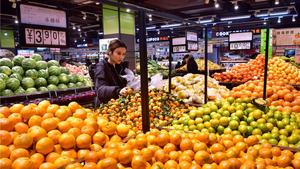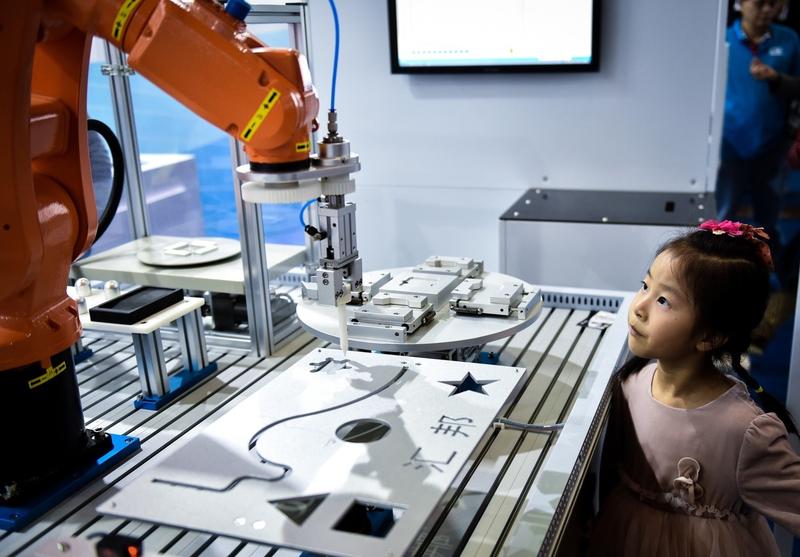 Towers rise up into the sky in this view of Beijing's central business district, Sept 20, 2018. (PHOTO / IC)
Towers rise up into the sky in this view of Beijing's central business district, Sept 20, 2018. (PHOTO / IC)
BEIJING - China's economy grew 6.1 percent year-on-year in 2019, within the government's annual target of 6 to 6.5 percent, the National Bureau of Statistics said on Friday.
The reading was lower than the 6.6-percent growth registered in 2018.
Growth in the fourth quarter came in at 6 percent, the same as the growth rate in the third quarter, but lower than the 6.2-percent growth in the second quarter and the 6.4-percent growth in the first quarter, NBS data showed.
China's per capita GDP in 2019 reached US$10,276 at the average exchange rate, exceeding the 10,000-dollar mark, said NBS head Ning Jizhe
Facing rising risks and challenges at home and abroad, the overall performance of the national economy has been stable and the quality of development has been improving with major targets being met, laying a solid foundation for completing the building of a moderately prosperous society in all respects, said Ning Jizhe, head of the NBS, at a press conference.
Gross domestic product (GDP) totaled 99.09 trillion yuan (US$14.38 trillion) in 2019, with the service sector accounting for more than half of the total.
READ MORE: Premier says reform efforts will be pushed
The per capita GDP in 2019 reached US$10,276 at the average exchange rate, exceeding the 10,000-dollar mark, said Ning.
As a country with 1.4 billion people and a per capita GDP of more than US$10,000, China will contribute more to the development and progress of the world, Ning said.
According to the World Bank, the population of countries with per capita GDP above US$10,000 was nearly 1.5 billion in 2018. As China enters the ranks of such countries, their collective population will approach 3 billion, representing major progress in the economic and social development of the world, Ning explained.
Tertiary industry grows
The output of China's tertiary industry accounted for 53.9 percent of last year's GDP, up 0.6 percentage points year-on-year, the NBS said.
The industry contributed 59.4 percent of national economic growth, NBS data showed.
Consumption's underpinning role in boosting economic growth was further reinforced, as consumer spending contributed 57.8 percent of GDP growth in 2019.
 In this undated photo, a customer buys fruit at a supermarket in Shijiazhuang, capital of Hebei province. (JIA MINJIE / FOR CHINA DAILY)
In this undated photo, a customer buys fruit at a supermarket in Shijiazhuang, capital of Hebei province. (JIA MINJIE / FOR CHINA DAILY)
Service consumption kept booming, as the proportion of service consumption reached 45.9 percent of the per capita consumption expenditure of residents, up 1.7 percentage points from the previous year.
China made substantial progress in supply-side structural reform in 2019, with the energy consumption per unit of GDP declining 2.6 percent from one year earlier. The nation's industrial capacity utilization rate stood at 76.6 percent, up 0.1 percentage points year on year.
The vitality of market entities was further unleashed. Around 23.77 million new market entities were established last year, with an average of 20,000 new enterprises set up every day.
China's tertiary industry contributed 59.4 percent of national economic growth, NBS data showed
By the end of 2019, the total number of market entities had reached 120 million.
Industrial output expands
China's value-added industrial output, an important economic indicator, expanded 5.7 percent year-on-year last year, slowing from 6.2 percent growth in 2018, NBS data showed.
The growth rate was higher than that in the first 11 months of 2019, according to the NBS.
In December alone, China's industrial output expanded 6.9 percent year-on-year, up 0.7 percentage points from November.
The sub-index for production of China's purchasing managers' index gained 0.6 points to 53.2 in December, the highest in 2019, which suggests the recovery of production activities, said Wen Bin, a researcher with China Minsheng Bank.
READ MORE: China's industrial output growth pegged at 5.6%
China's industrial output, officially called industrial value added, is used to measure the activity of designated large enterprises with annual business turnover of at least 20 million yuan (about US$2.8 million).
Ning said the country's major economic indicators posted positive changes in the fourth quarter of 2019
Ning said the country's major economic indicators posted positive changes in the fourth quarter of 2019. The industrial output grew 6 percent year-on-year from October to December, up one percentage point from the third quarter.
In a breakdown by ownership, the output of state-holding enterprises climbed 4.8 percent in 2019, while joint-stock companies went up 6.8 percent, and overseas-funded enterprises rose by 2 percent.
The production and supply of electricity, thermal power, gas and water reported a year-on-year increase of 7 percent in 2019, the fastest among the three major sectors, which also include mining and manufacturing.
Manufacturing output rose 6 percent year-on-year, while mining output edged up 5 percent, the NBS said.
Thirty-three of the 41 sectors monitored by the NBS recorded increasing output in December, with electrical machinery and equipment manufacturing as well as automobile manufacturing maintaining fast expansion.
Industrial structure continued to improve last year, reporting an annual industrial capacity utilization rate of 76.6 percent, up 0.1 percentage points from a year earlier, Ning said.
He also noted that China strengthened innovation last year, seeing the expansion of new impetus and new industries. Production in high-tech manufacturing industries and strategic emerging industries expanded by 8.8 percent and 8.4 percent, respectively.
 In this undated photo, a girl watches an AI-supported robot arm making a billboard during a high-tech exhibition in Shenzhen, Guangdong province. (PHOTO / XINHUA)
In this undated photo, a girl watches an AI-supported robot arm making a billboard during a high-tech exhibition in Shenzhen, Guangdong province. (PHOTO / XINHUA)
Fixed-asset investment increases
Meanwhile, China's fixed-asset investment increased 5.4 percent year-on-year in 2019, 0.2 percentage points higher than the level recorded in the first 11 months, the NBS said.
The fixed-asset investment amounted to 55.15 trillion yuan (US$8.02 trillion) last year, according to the NBS.
In December alone, the fixed-asset investment went up 0.44 percent from November.
The investment in high-tech industries registered an outstanding growth of 17.3 percent year-on-year in 2019
ALSO READ: Economy's resilience, infrastructure shine in 2019 data
The investment in high-tech industries registered an outstanding growth of 17.3 percent year-on-year in 2019, with the fixed-asset investment in high-tech manufacturing and service sectors up 17.7 percent and 16.5 percent, respectively.
Private investment grew 4.7 percent to 31.12 trillion yuan last year.
Gross capital formation, another measure for investment, contributed 31.2 percent of China's economic growth last year, said Ning.
In breakdown, the investment in the primary industry gained 0.6 percent last year, compared with a 0.1 percent decrease in the first 11 months. The investment in the secondary industry went up by 3.2 percent, while the investment in the tertiary industry expanded 6.5 percent in 2019.
Resident disposable income increases
China's per capita disposable income stood at 30,733 yuan (US$4,461.95) in 2019, up 5.8 percent year-on-year in real terms, NBS data showed.
Separately, urban and rural per capita disposable income reached 42,359 yuan and 16,021 yuan in 2019, up 5 percent and 6.2 percent in real terms after deducting price factors, respectively, according to the NBS.
In 2019, the real growth of per capita disposable income in rural areas was faster than that in urban areas, indicating narrowing of the urban-rural income gap, according to the NBS data.
Chinese per capita consumer spending increased by 5.5 percent year-on-year in real terms to reach 21,559 yuan in 2019.
By 2020, China aims to double the per capita income of its urban and rural residents from 2010 levels.
 Shoppers look at shoes in a shopping mall in Nanjing, Jiangsu province, on June 17, 2019. (PHOTO PROVIDED TO CHINA DAILY)
Shoppers look at shoes in a shopping mall in Nanjing, Jiangsu province, on June 17, 2019. (PHOTO PROVIDED TO CHINA DAILY)
Retail sales rise
China's retail sales of consumer goods, a major indicator of consumption growth, rose 8 percent year-on-year in 2019, the NBS said.
ALSO READ: 'First-store economy' further fuels consumption in China
Consumption remained the Chinese economy's top growth driver, with its contribution to GDP expansion at 57.8 percent.
Sales of consumer goods totaled some 41.16 trillion yuan (about US$5.99 trillion) last year. In December, the indicator rose 8 percent year-on-year.
Retail sales in rural areas rose 9 percent, outpacing the 7.9-percent expansion in urban areas.
Online sales continued to report robust expansion, with a year-on-year increase of 16.5 percent to top 10 trillion yuan in 2019, NBS data showed.
Consumption remained the Chinese economy's top growth driver, with its contribution to GDP expansion at 57.8 percent.
Friday's data pointed to China's ongoing consumption upgrading, as the country's large retailers of cosmetics, telecom equipment, sports and entertainment products posted faster sales growth than their peers.
The head of NBS expected consumption to further play its fundamental role in powering China's economic growth in 2020, as consumers' willingness to spend picks up with their rising incomes, market reforms and the enhanced supply of quality products and services.
Employment stable
China's job market remained stable in 2019, with all related indicators meeting the annual goals, the NBS.
A total of 13.52 million new urban jobs were created last year, exceeding the target of creating over 11 million urban jobs, NBS data showed.
2019 was the seventh year in a row for China to create over 13 million urban jobs
READ MORE: China outlines measures to keep employment stable
The figure marked the seventh year in a row for China to create over 13 million urban jobs.
The registered urban unemployment rate stood at 3.62 percent at the end of 2019, well below the government's annual ceiling of 4.5 percent.
The surveyed urban unemployment rate nationwide stood at 5.2 percent in December. The monthly indicator all reached between 5 percent and 5.3 percent throughout 2019, also below the official ceiling.
China's migrant worker population grew 0.8 percent to top 290.8 million, while their average monthly income rose 6.5 percent to 3,962 yuan (about US$582), NBS data showed.


